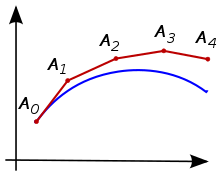
Back طريقة أويلر Arabic Eyler üsulu Azerbaijani Mètode d'Euler Catalan Eulerova metoda Czech Eulers metode Danish Explizites Euler-Verfahren German Μέθοδος Όιλερ Greek Método de Euler Spanish Eulerren metodo Basque Eulerin menetelmä Finnish

| Differential equations |
|---|
| Scope |
| Classification |
| Solution |
| People |
In mathematics and computational science, the Euler method (also called the forward Euler method) is a first-order numerical procedure for solving ordinary differential equations (ODEs) with a given initial value. It is the most basic explicit method for numerical integration of ordinary differential equations and is the simplest Runge–Kutta method. The Euler method is named after Leonhard Euler, who first proposed it in his book Institutionum calculi integralis (published 1768–1770).[1]
The Euler method is a first-order method, which means that the local error (error per step) is proportional to the square of the step size, and the global error (error at a given time) is proportional to the step size. The Euler method often serves as the basis to construct more complex methods, e.g., predictor–corrector method.
- ^ Butcher 2003, p. 45; Hairer, Nørsett & Wanner 1993, p. 35
© MMXXIII Rich X Search. We shall prevail. All rights reserved. Rich X Search